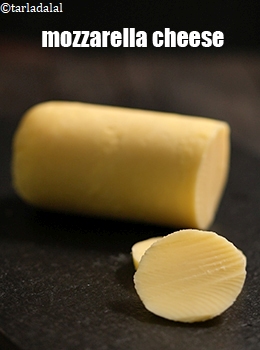
Description
Mozzarella (derived from the Italian word mozzare, which means, 'to cut') is originally an Italian cheese, crafted using the technique of spinning before being cut. This semi-soft, white cheese, has high moisture content, melts easily, and has a bland, buttery flavour and is traditionally produced solely from the milk of the domestic water buffalo. After curdling, the product is drained and the whey discarded. The cheese is then stretched and kneaded by hand to produce a delicate consistency. When slightly desiccated (partially dried), mozzarella is best used to prepare dishes cooked in the oven, like lasagna. When twisted to form a plait it is called treccia. Mozzarella is also available in smoked (called affumicata) and reduced-moisture packaged varieties.
Chopped mozzarella cheese
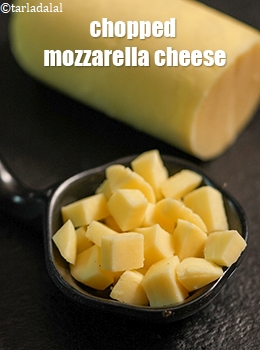
Place the cheese slab on a chopping board and chop it into either 1/2 inch or 1 inch pieces as per the recipe requirement. Make sure they are evenly chopped so that even melting is ensured.
Diced mozzarella cheese
.jpg)
Diced Mozzarella has a moist, soft and an elastic texture and has a distinctive mild salty taste and a pleasant aroma. Due to its elastic and stringy texture, this cheese is ideal for preparing Lasagna, and as a topping on pizzas. Readymade diced cheese is available in the market but you can also dice the mozzarella cheese block into small pieces.
Grated mozzarella cheese

This requires grating the cheese slabs in a hand held grater. This grated cheese is fine in texture and is used for making baked dishes like au gratin or casseroles.
Mozzarella cheese cubes
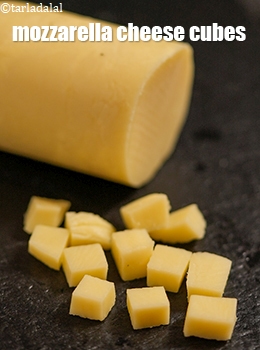
Turn the block of cheese on its side and make a series of slices. Lay the cheese slices on top of each other and make a series of lengthwise slices, (½ inch slices for smaller cubes, 1 inch slices for larger cubes. Make a series of ½ inch or 1 inch crosswise cuts through the cheese and it will fall away into cubes.
Mozzarella cheese slices
You may place the cheese on a chopping board and slice the cheese in thin or thick slices with a sharp knife, as per the recipe requirement.
Mozzarella cheese strips
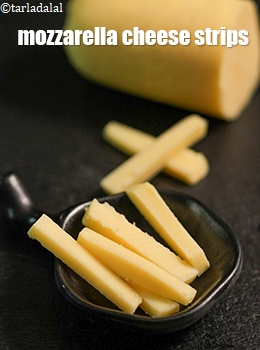
Cut the cheese into thin or thick strips as per recipe requirement.
Shredded mozzarella cheese
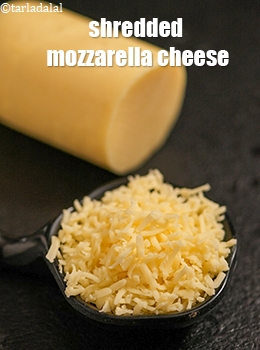
Pass the cheese through a shredder and separate the thin slices into shreds with fingers. Alternatively, you may buy packaged shredded cheese.
Sliced mozzarella cheese

You may place the cheese in a slicer or slice the cheese in thin or thick slices with a sharp knife, as per the recipe requirement.
How to select
• Mozzarella cheese, should be smooth and evenly coloured without signs of cracking or discoloration.
• The young cheese is somewhat perishable, so it should be used quickly.
• Check the best before date before buying.
BUY
Culinary uses
• With its mild-to-mellow flavour, it is perfect for snacking, slicing, or melting on Mexican dishes.
• Most commonly eaten fresh, Mozzarella cheese can be used as a substitute for Parmesan on pasta.
• It is a popular cheese for snacking on, on its own or with crackers.
• It is especially flavourful in melted dishes such as soup and sauce recipes
• A few dishes which may use Mozzarella cheese are mashed potatoes, shepherd's pie, macaroni and cheese, casseroles, etc.
• Cheese tastes superb between toasted wheat breads with cucumber and tomato slices.
• Mozzarella cheese can be added to omelettes, pizza, soufflés, au gratins, fondues, etc.
How to store
• All cheeses, regardless of variety, should be well wrapped and kept in the warmest section of the refrigerator. (The refrigerator door is often one of the warmest spots).
• As storage life is related to the moisture content of the cheese, the softer the cheese, the shorter amount of time it will keep fresh.
Health Benefits
• Regardless of the type of milk used to create it, Mozzarella cheese is a concentrated source of the nutrients naturally found in milk, including calcium.
• The one nutritional drawback of reduced-fat cheeses is that they are usually higher in sodium than full-fat natural cheeses.
• Mozzarella also contains a large amount of other essential nutrients such as phosphorous, zinc, riboflavin, vitamin B12 and vitamin A.
• It is a dense source of high quality protein.